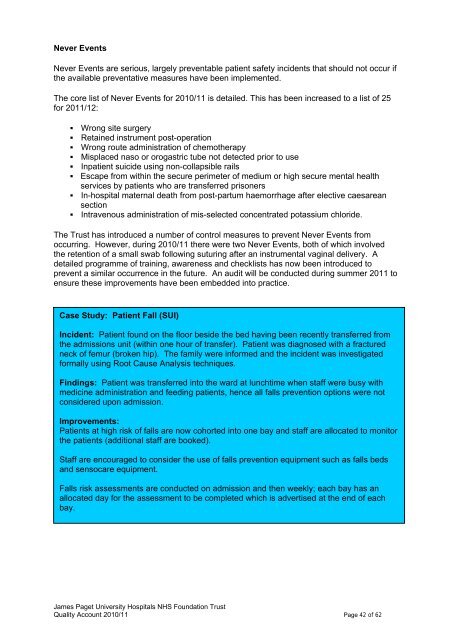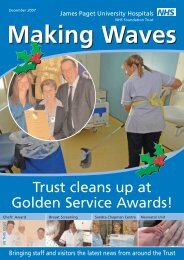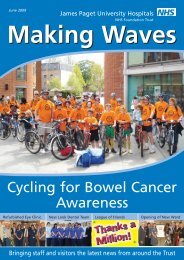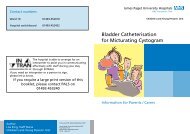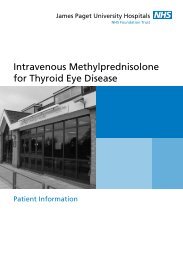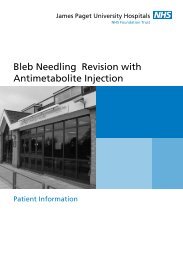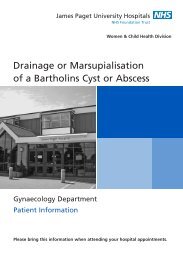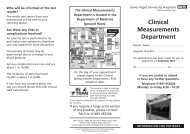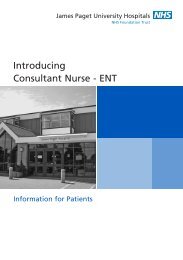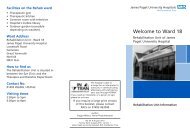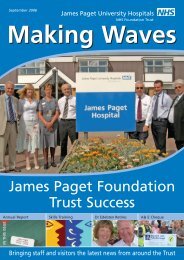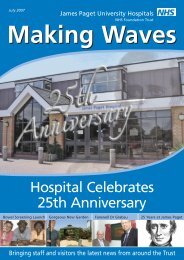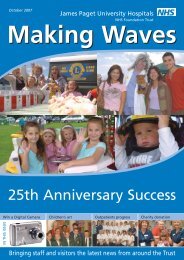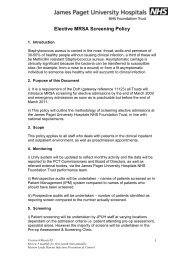Annual Report & Accounts 2010/11 - James Paget University Hospitals
Annual Report & Accounts 2010/11 - James Paget University Hospitals
Annual Report & Accounts 2010/11 - James Paget University Hospitals
You also want an ePaper? Increase the reach of your titles
YUMPU automatically turns print PDFs into web optimized ePapers that Google loves.
Never Events<br />
Never Events are serious, largely preventable patient safety incidents that should not occur if<br />
the available preventative measures have been implemented.<br />
The core list of Never Events for <strong>2010</strong>/<strong>11</strong> is detailed. This has been increased to a list of 25<br />
for 20<strong>11</strong>/12:<br />
• Wrong site surgery<br />
• Retained instrument post-operation<br />
• Wrong route administration of chemotherapy<br />
• Misplaced naso or orogastric tube not detected prior to use<br />
• Inpatient suicide using non-collapsible rails<br />
• Escape from within the secure perimeter of medium or high secure mental health<br />
services by patients who are transferred prisoners<br />
• In-hospital maternal death from post-partum haemorrhage after elective caesarean<br />
section<br />
• Intravenous administration of mis-selected concentrated potassium chloride.<br />
The Trust has introduced a number of control measures to prevent Never Events from<br />
occurring. However, during <strong>2010</strong>/<strong>11</strong> there were two Never Events, both of which involved<br />
the retention of a small swab following suturing after an instrumental vaginal delivery. A<br />
detailed programme of training, awareness and checklists has now been introduced to<br />
prevent a similar occurrence in the future. An audit will be conducted during summer 20<strong>11</strong> to<br />
ensure these improvements have been embedded into practice.<br />
Case Study: Patient Fall (SUI)<br />
Incident: Patient found on the floor beside the bed having been recently transferred from<br />
the admissions unit (within one hour of transfer). Patient was diagnosed with a fractured<br />
neck of femur (broken hip). The family were informed and the incident was investigated<br />
formally using Root Cause Analysis techniques.<br />
Findings: Patient was transferred into the ward at lunchtime when staff were busy with<br />
medicine administration and feeding patients, hence all falls prevention options were not<br />
considered upon admission.<br />
Improvements:<br />
Patients at high risk of falls are now cohorted into one bay and staff are allocated to monitor<br />
the patients (additional staff are booked).<br />
Staff are encouraged to consider the use of falls prevention equipment such as falls beds<br />
and sensocare equipment.<br />
Falls risk assessments are conducted on admission and then weekly; each bay has an<br />
allocated day for the assessment to be completed which is advertised at the end of each<br />
bay.<br />
<strong>James</strong> <strong>Paget</strong> <strong>University</strong> <strong>Hospitals</strong> NHS Foundation Trust<br />
Quality Account <strong>2010</strong>/<strong>11</strong> Page 42 of 62


